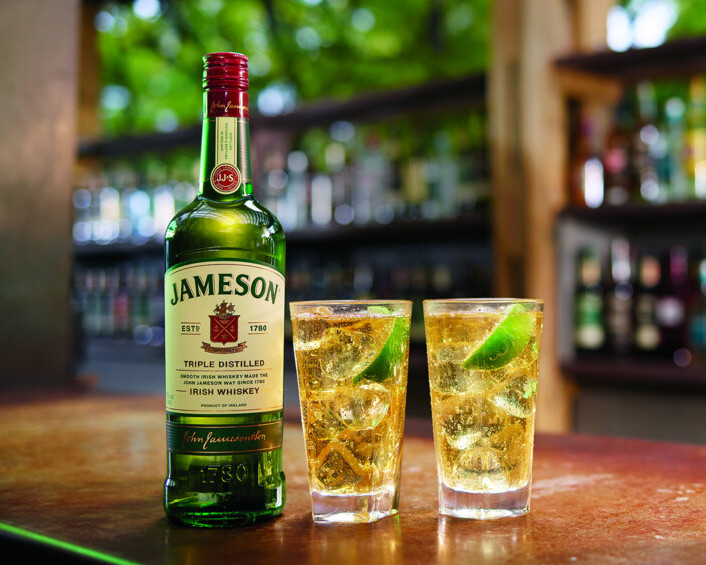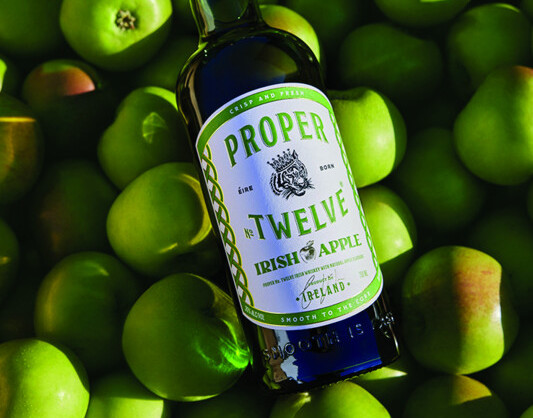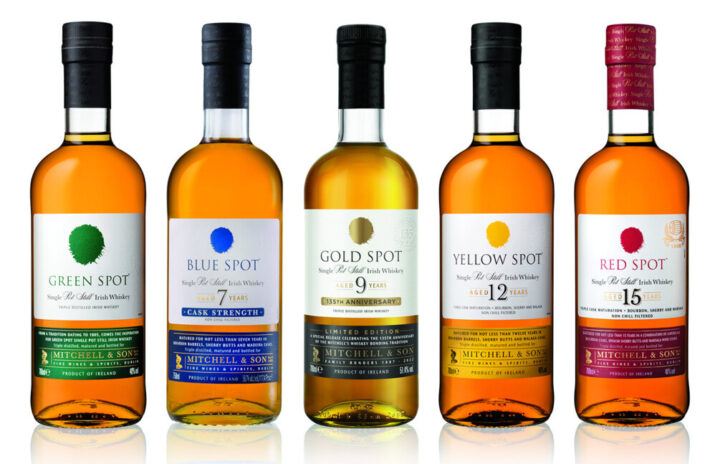
Following a slight stall in momentum in 2020, Irish whiskey is firmly back in growth mode, with nearly every top brand eking out gains. In all, Irish whiskey reached a milestone 15 million cases worldwide last year, according to Impact Databank, following global growth of 11.5%. Long-time category leader Jameson remains at the fore with 4.241 million cases in the U.S.—on growth of 4.4%. For Jameson, and most other Irish whiskey labels currently experiencing gains, innovative, super-premium expressions are behind the consistent progress.

Longtime Leaders Transform
Over the past decade, Jameson has revamped its image thanks to various higher-end line extensions, among them Black Barrel ($35 a 750-ml.), a triple-distilled blend of small batch grain and single pot still whiskeys; Caskmates Stout and IPA editions (both $30), aged in beer barrels; and Cold Brew ($25), whiskey infused with coffee flavor. Additional flavor extensions and the introduction of RTDs like Jameson Ginger & Lime ($15 a 4-pack of 12-ounce cans) have also bolstered growth. “Our research has shown that 72% of U.S. consumers buying Jameson Ginger & Lime are new to the Jameson family,” says Irish Distillers business acceleration director Simon Fay. Jameson Orange ($30 a 750-ml.), meanwhile, was launched last year, and has similarly expanded the brand’s audience, earning Impact “Hot Brand” status by reaching 215,000 cases in its first year on the market.
At retail, Jameson’s dominance is abundantly clear. “As far as sales go, Jameson still wins the category by a country mile,” says Chris McNeal, spirits manager at Molly’s Spirits in Greenwood Village, Colorado. “Bushmills and Tullamore D.E.W. do alright, but they’re at a fraction of Jameson’s sales.” He notes that the store carries around 30 brands, and between them there are about 65 individual Irish whiskey SKUs.
Bushmills, the fourth-ranked Irish whiskey in the U.S. by volume, has also targeted the super-premium side. Two permanent additions to the Bushmills age statement single malt whiskeys were introduced earlier this year: Bushmills 25-year-old ($900 a 750-ml.) and Bushmills 30-year-old ($2,200). “Tapping into Ireland’s largest stock of aged single malt whiskey, Bushmills leads with innovation at the ultra-premium and prestige end of Irish whiskey,” says Lander Otegui, senior vice president of marketing at parent company Proximo Spirits. At a slightly lower price point is Bushmills 12-year-old single malt ($60), which landed at No. 20 on Market Watch sister publication Whisky Advocate’s Top 20 Whiskies of 2022. In addition to age statement whiskies, Bushmills is also exploring cask finishes through its Rare Casks collectible series, which debuted in 2020 with a Cognac cask-finished single malt ($500) and has since added two additional whiskeys. To meet demand, the brand opened the Causeway Distillery in April, which is expected to double Bushmills’ single malt production capabilities.
Also from Proximo Spirits is Proper No. Twelve ($25 a 750-ml.), which debuted in 2018 and has since skyrocketed in volume, amassing 276,000 cases to take the No.-3 spot in the U.S. Co-founded by Irish MMA fighter Conor McGregor in 2018, Proper No. Twelve first found success with its flagship blended whiskey, but more recently the brand has focused in on a flavored line extension, releasing the Irish Apple ($25) variant earlier this year. While the brand’s volume slipped 1.5% in 2022, Otegui is confident the line extension will play a role in its return to growth, as the brand already appears to be rebounding. “We had record Irish Apple sales nationwide immediately following the launch, and we’ve continued to see sales rise throughout the year,” he says.
The No.-2 Irish whiskey brand in the U.S., Tullamore D.E.W., has expanded far beyond its flagship whiskey over the years, with a roster that now includes Cider Cask Finish, XO Caribbean Rum Cask Finish, and various age statement whiskeys (the portfolio retails for $19-$445 a 750-ml.). While the brand managed minor gains in the U.S. last year, its global volume fell by 4.9% to 1.39 million cases due to a number of supply issues, chief among them a fire at its glass supplier that halted production. There’s plenty of reason for optimism, however. “The outlook for 2023 is positive as we recover from those supply issues and Irish whiskey continues to trend,” says Tullamore D.E.W. brand ambassador Paul Coffey. “Irish whiskey has been one of the fastest growing spirits categories over the last decade.”

Small But Mighty
Newer to the category is Brown-Forman-owned Slane, which launched in 2015 and now counts itself among the top ten brands in the U.S. Slane is currently at 28,000 cases stateside; last year, it was one of the few brands to register double-digit gains, jumping by 29.5%. At the heart of Slane is its Triple Cask whiskey ($30 a 750-ml.), which is, as the name implies, aged in three different casks: virgin oak, seasoned oak, and Sherry. Slane co-founder Alex Conyngham notes that even as line extensions come on stream, they’ll have the same DNA as the flagship. “Each of our expressions is matured in our signature triple-cask method, but the ratio of each barrel in the final bottle varies depending on the expression; for instance, our Special Edition blend has an increased amount of virgin oak, and the same applies to our Extra Sherry Wood expressions,” he says. “Therefore, there may be stronger tasting notes in each expression, but you’ll still get that lovely balance of vanilla spice and caramel that’s found in all of our whiskeys.”
In recent years, Irish Distillers has placed a great deal of emphasis on its super-premium and luxury labels, including Redbreast, Powers, Midleton Very Rare, the Spot whiskeys, and Method and Madness. “Irish Distillers’ prestige range of whiskeys are preforming incredibly well, having experienced volume growth of 26% in the first six months of the financial year,” says Fay. “This was driven by the Redbreast family, which is up 20%, surpassing 100,000 cases in 2022.”
Redbreast, whose core 12-year-old expression comes in at $65 a 750-ml., is among the top five Irish whiskey brands in the U.S., with volume of 63,000 cases. The brand has kept innovation top of mind, coming out with the American Oak series in 2022, which champions the influence of American oak from various parts of the U.S. The range launched with Kentucky Oak ($96)—for the release, Irish Distillers tapped the Taylor family, renowned for their sustainable forestry practices, to select oaks from the Elk Cave Farm in Gravel Switch, Kentucky.
The Spot portfolio, meanwhile, is also among the top ten Irish whiskey brands in the U.S., with volume of 26,000 cases on the heels of 34.5% growth. This was in part bolstered by two releases: Blue Spot ($94 a 750-ml.) in 2020 and Gold Spot ($120) in 2022. While Blue Spot—a single pot still whiskey matured in Bourbon, Sherry, and madeira casks—was a reintroduction to the Spot range, Gold Spot is entirely new; the 9-year-old whiskey, also a single pot still, was matured in four different cask types, including Port pipes, which the brand had never used before.

Single Pot Still, Single Malt Success
Redbreast, the Spot, and several other super-premium brands within the Irish Distillers portfolio—and other distilleries—have rooted their success in one style that’s distinctly Irish: single pot still. The quintessentially Irish whiskey is characterized as being made within a single distillery using a mash of at least 30% malted and 30% unmalted barley, with up to 5% of other grains added. At Teeling Distillery, whose total volume is 27,000 cases, single pot still whiskeys are lending themselves to the distillery’s ongoing growth. “Single pot still is still tiny, it’s only a small subsection of Irish whiskey, so there’s a huge amount of runway, and quite a buzz about it as well,” says Stephen Teeling, a second-generation family member and sales and marketing director at the distillery. “There’s a huge amount of pride around this style in Ireland as well, and the interesting part for us has been taking something that’s old and traditional and introducing it in a modern way.” To that end, the distillery offers a core single pot still whiskey ($65 a 750-ml.), as well as a more recently released luxury lineup under the Wonders of Wood moniker. The inaugural whiskey, Chinkapin Oak ($99 a 750-ml.)—which debuted in 2022—matured entirely in new chinkapin American white oak barrels; this year’s release, Portuguese Wood ($100), aged in virgin Portuguese oak barrels.
While Irish single pot still is relatively small in scale compared to blends and grain whiskeys, taking up an even smaller share of the overall category are Irish single malts. Teeling notes that the style has long been under-serviced in Ireland, but the distillery is aiming to change that. “As we see Irish single malt expand, you’re not going to see walls and walls of blended Irish whiskeys anymore; there’s a good cohort of producers making Irish single malts, bringing it up to a level that’s talked about.” For its part, Teeling’s portfolio includes a number of ultra-aged single malts, including 24-, 28-, 30-, and 37-year-old whiskeys ($500+ a 750-ml.), as well as Blackpitts ($75), a peated single malt.
On the west coast of Ireland, Dingle Distillery has made its name in single malt whiskey, albeit in minuscule quantities. “Irish whiskey itself, even though it’s technically been around a long time, is very much in its infancy as it is now,” says Dingle master distiller Graham Coull. “So there’s a long way to go, and single malt is an easier conversation to have with people, than, say, single pot still; they understand single malt, because it’s made all across the world, and generally with somewhat similar rules.” Around 75% of the distillery’s production goes toward single malt, with the remainder reserved for single pot still. The core range—the Batch Series—features single malts that are finished in 40% Bourbon, 40% Sherry, and 20% Port, madeira, rum, or other wine cask; each batch is generally 10,000 bottles or less. Coull points to Dingle’s Wheel of the Year range as the smaller batch, more experimental little brother of the Batch Series; its single malts see maturation in a variety of cask types, among them muscatel, rye, and Widow Jane Bourbon.
With supply issues for Scotch producers and high-end Bourbons perennially hard to find, customers at Kentucky-based retailer The Party Source have turned to Irish single pot and single malt whiskeys as high-end alternatives. “A lot of people picking up Irish whiskey at our store are people that are in-between their whiskey journey—it can be difficult and tedious to find some Bourbons and Scotch, and so we’re seeing some spillover into the Irish, particularly in the $50-$70 range,” says store manager Marty Holland. “That means Redbreast, the Spots, Connemara, and Tyrconnell single malts, while Jameson, Paddy’s, and lower-priced, blended whiskeys are declining a bit.”

A Lengthy Runway Ahead
Just this year, Irish whiskey makers have turned their sights on yet another style: rye. Irish Distillers planted its flag in rye with two releases, one a 100% rye from Powers, and the other a blend of 60% rye and 40% malted barley under the Method and Madness umbrella. Powers rye ($32 a 750-ml.) is the first 100% Irish rye whiskey, with the rye for the release grown in County Wexford, Ireland, on a farm close to the ancestral home of the Powers family. Irish Distillers was inspired to create the whiskey after the company archivist found historical evidence that John Power & Son experimented with rye in its old mashbills; previously, existing commercial agriculture in Ireland hadn’t met the requirements for rye demanded by Irish Distillers, so they commissioned it from elsewhere.
Given the influx of new releases, and the uptick in new distilleries—from four distilleries in 2010 to over 40 now—Irish whiskey seems poised for far more growth. The category has undergone a complete overhaul in the past decade; no more is it confined to blended whiskeys, but instead, a wide variety of styles are on offer, with cask finishes galore. “For many years, Irish whiskey was an ode to the past, rather than a look to the future,” says Teeling. “We were stuck back in the good ol’ days. But now, we’re writing a new chapter for it, and there’s no end in sight—we’re powering ahead.”